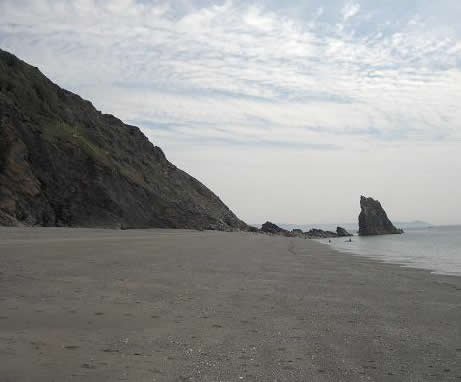Sea Stacks
Stacks are easy to recognise because they stand alone, no longer attached to the cliffs. At high tide they will usually be tall rocks rising from the sea just off the shore, though at low tide you may be able to walk out to them across the beach.
Stacks form when there is an area of weakness in the cliffs that can be attacked by the sea, weakened further, and eroded away. The most typical way in which this happens is when a weakness in an exposed headland becomes a cave, the cave is enlarged from both ends to form an arch, and finally the top of the arch collapses leaving the seaward pillar (the upright bit nearest the sea) as a stack.
You will have realised now that stacks are erosional features, because they are formed by erosional processes.
The presence of isolated stacks may indicate a change in the type of rock forming the cliff line. For example, a volcanic intrusion or a lava flow may be much more resistant to erosion than the surrounding rocks. Over time the softer rocks erode away leaving a strip of much more resistant rock exposed to the sea. Harder rocks will stay around longer, increasing the chances of the rock remaining long enough for a stack to be formed. You can deduce from this that very soft and easily eroded rocks are unlikely to form a stack because they will not withstand the action of the sea for a long enough period of time.
Sometimes a line of stacks will be formed, such as The Needles off the Isle of Wight,UK. When this happens the stacks furthest from the coastline will often be more worn down than those closer to the shore because they are the older ones.
Over time, all stacks are worn down. A stack that has been reduced to a short pillar is known as a stump. Stumps may be hidden at high tide and only become visible as the tide goes out.
This stack was photographed near the village of Seaton, on the Cornish coast not far from Plymouth. It is a good example of how hard igneous rocks can 'outlive' the surrounding softer sedimentary rocks and become isolated as the cliff line recedes. The surrounding cliffs are of much softer sedimentary types including shale and sandstones. These are relatively easily eroded away to leave the strip of volcanic rock exposed. The stack is now over 100m closer to the sea than the present cliffs, and is joined to them by a low ridge of very fractured and broken rocks. The poor condition of the rocks between the stack and the cliffs would have made them more vulnerable to erosion than the remaining stack which has very few joints and weaknesses. Two additional features are worth noting. Firstly, there is a darker line around the base of the stack, separating a lower,brown area from the upper dark grey area. This line represents the high tide mark and indicates the general boundary between areas subject to sea water and atmosphere based weathering processes. Secondly, there are light grey / white streaks running down the upper slopes of the stack. These are droppings left by sea gulls, cormorants and other sea birds. Stacks are often popular as nesting sites for birds because of their seclusion, the lack of predators and easy access to food. Many stacks have become important bird breeding sites and are protected by law. |
|
 d d |
From this photograph you can see how the stack was once part of a long ridge of hard rock linking it to the rest of the cliffs. Over the years the cliff line has receded, although this process has been slower between the stack and the cliff than it has been elsewhere on the beach. The beach is grey because it is made from a mixture of sand and tiny pebbles that are the weathered remains of the grey rocks forming the cliffs. In the distance (behind and to the right of the stack) you can see a low grey shape. This is a distant headland, Rame Head, where igneous rocks similar to those forming the stack can be found. |
![]()
